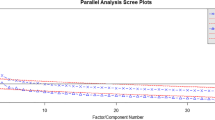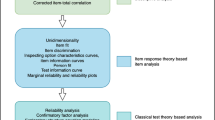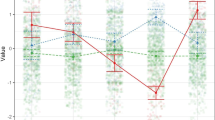Abstract
Objectives
Numerous studies have documented the positive effects of mindfulness practice on the alleviation of various kinds of psychological distress, but a dearth of evidence remains related to the validity of common mindfulness instruments in Indian populations. The present study aimed to explore the higher-order construct of mindfulness in India and evaluate the psychometric properties of the widely used 39-item Five Facet Mindfulness Questionnaire-English-language version (FFMQ) on a sample recruited from India.
Methods
Adults (n = 300) between the age range of 20 and 35 years who have neither had experience nor exposure to any previous meditative technique participated in this study. Using Rasch analysis, various FFMQ models were tested. To support the findings of Rasch analysis and to provide continuity with some of the past research, confirmatory factor analysis (CFA) was also performed to validate our findings.
Results
Adequate Rasch analysis fits were not achieved for the conventional five-factor model but further iterative analysis identified three misfitting items of the Describing facet (items 12, 16, and 22). Using a subtest approach, a modified five-factor solution without the three misfitting items provided an acceptable fit, which was subsequently confirmed by the CFA.
Conclusion
This study confirmed the suitability of the higher-order structure of the FFMQ for use in India. The English-language version of the FFMQ has been shown to have good psychometric properties if three items from the Describing facet are removed.



Similar content being viewed by others
References
Aguadon, J., Luciano, J. V., Cebolla, A., Serrano-Blanco, A., Soler, J., & García-Campayo, J. (2015). Bifactor analysis and construct validity of the Five Facet Mindfulness Questionnaire (FFMQ) in non-clinical Spanish samples. Frontiers in Psychology, 6, 1–14.
Andrich, D., Sheridan, B., & Luo, G. (2009). RUMM 2030. Perth: RUMM Laboratory.
Baer, R. (2003). Mindfulness training as a clinical intervention: A conceptual and empirical review. Clinical Psychology: Science and Practice, 10(2), 125–142.
Baer, R. A., Smith, G. T., & Allen, K. B. (2004). Assessment of mindfulness by self-report: The Kentucky inventory of mindfulness skills. Assessment, 11(3), 191–206.
Baer, R., Smith, G., Hopkins, J., Krietemeyer, J., & Toney, L. (2006). Using self-report assessment methods to explore facets of mindfulness. Assessment, 13(1), 27–45.
Baer, R., Smith, G., Lykins, E. L. B., Button, D., Krietemeyer, J., Sauer, S., Walsh, E., Duggan, D., & Williams, J. M. G. (2008). Construct validity of the Five Facet Mindfulness Questionnaire in meditating and non-meditating samples. Assessment, 15(3), 329–342.
Balalla, S. K., Medvedev, O. N., Siegert, R. J., & Krägeloh, C. U. (2019). Validation of the WHOQoL-BREF and shorter versions using Rasch analysis in traumatic brain injury and orthopaedic populations. Archives of Physical Medicine and Rehabilitation, 100(10), 1853–1862.
Bergomi, C., Tschacher, W., & Kupper, Z. (2013). The assessment of mindfulness with self-report measures: Existing scales and open issues. Mindfulness, 4(3), 191–202.
Brown, K. W., & Ryan, R. M. (2003). The benefits of being present: Mindfulness and its role in psychological well-being. Journal of Personality and Social Psychology, 84(4), 822–848.
Buchheld, N., Grossman, P., & Walach, H. (2001). Measuring mindfulness in insight meditation (vipassana) and meditation-based psychotherapy: The development of the Freiburg Mindfulness Inventory (FMI). Journal for Meditation and Meditation Research, 1, 11–34.
Cardaciotto, L. A., Herbert, J. D., Forman, E. M., Moitra, E., & Farrow, V. (2008). The assessment of present-moment awareness and acceptance: The Philadelphia Mindfulness Scale. Assessment, 15(2), 204–223.
Chadwick, P., Hember, M., Symes, J., Peters, E., Kuipers, E., & Dagnan, D. (2008). Responding mindfully to unpleasant thoughts and images: Reliability and validity of the Southampton Mindfulness Questionnaire (SMQ). The British Journal of Clinical Psychology, 47(4), 451–455.
Christopher, M. S., Neuser, N. J., Michael, P. G., & Baitmangalkar, A. (2012). Exploring the psychometric properties of the Five Facet Mindfulness Questionnaire. Mindfulness, 3(2), 124–131.
De Bruin, E. I., Topper, M., Muskens, J. G. A. M., Bögels, S. M., & Kamphuis, J. H. (2012). Psychometric properties of the Five Facets Mindfulness Questionnaire (FFMQ) in a meditating and a non-meditating sample. Assessment, 19(2), 187–197.
Deng, Y. Q., Liu, X. H., Rodriguez, M. A., & Xia, C. Y. (2011). The Five Facet Mindfulness Questionnaire: Psychometric properties of the Chinese version. Mindfulness, 2(2), 123–128.
Feldman, G. C., Hayes, A. M., Kumar, S. M., & Greeson, J. M. (2004). Development, factor structure, and initial validation of the Cognitive and Affective Mindfulness Scale. Unpublished manuscript.
Flora, D. B., & Curran, P. J. (2004). An empirical evaluation of alternative methods of estimation for confirmatory factor analysis with ordinal data. Psychological Methods, 9(4), 466–491.
Giovannini, C., Giromini, L., Bonalume, L., Tagini, A., Lang, M., & Amadei, G. (2014). The Italian Five Facet Mindfulness Questionnaire: A contribution to its validity and reliability. Journal of Psychopathology and Behavioral Assessment, 36, 415–423.
Gordon, I. K. (2018). Factor structure and external validity of the Five-Facet Mindfulness Questionnaire in pregnancy. Mindfulness, 9(1), 243–257.
Gu, J., Strauss, C., Crane, C., Barnhofer, T., Karl, A., Cavanagh, K., & Kuyken, W. (2016). Examining the factor structure of the 39-item and 15-item versions of the Five Facet Mindfulness Questionnaire before and after mindfulness-based cognitive therapy for people with recurrent depression. Psychological Assessment, 28(7), 791–802.
Haas, B. W., & Akamatsu, Y. (2019). Psychometric investigation of the five facets of mindfulness and well-being measures in the Kingdom of Bhutan and the USA. Mindfulness, 10(7), 1339–1351.
Hall, E. T. (1976). Beyond culture. Doubleday.
Hayes, S. C., Follette, V. M., & Linehan, M. M. (Eds.). (2004). Mindfulness and acceptance: Expanding cognitive behavioral tradition. The Guilford Press.
Heeren, A., Douilliez, C., Peschard, V., Debrauwere, L., & Philippot, P. (2011). Cross cultural validity of the Five Facets Mindfulness Questionnaire: Adaptation and validation in a French-speaking sample. European Review of Applied Psychology, 61(3), 147–151.
Hermida, R. (2015). The problem of allowing correlated errors in structural equation modeling: Concerns and considerations. Computational Methods in Social Sciences, 3(1), 5–17.
Hobart, J., & Cano, S. (2009). Improving the evaluation of therapeutic interventions in multiple sclerosis: The role of new psychometric methods. Health Technology Assessment, 13(12), 1–200.
Jöreskog, K. G., & Sörbom, D. (1993). LISREL 8: Structural equation modelling with the SIMPLIS command language. Hillsdale: Erlbaum Associates.
Joshi, S. K. (2020). The linguistic landscape of India. Heritage: India Perspectives, Issue 4.
Kabat-Zinn, J. (2003). Mindfulness-based interventions in context: Past, present, and future. Clinical Psychology: Science and Practice, 10(2), 144–156.
Kabat-Zinn, J. (2005). Bringing mindfulness to medicine: An interview with Jon Kabat-Zinn, PhD Interview by Karolyn Gazella. Advances in Mind Body Medicine, 21(2), 22–27.
Kachru, B. B. (1986). The Indianization of English. English Today, 2(2), 31–33.
Kim, E., Krägeloh, C. U., Medvedev, O. N., Duncan, L. G., & Singh, N. N. (2019). Interpersonal mindfulness in parenting scale: Testing the psychometric properties of a Korean version. Mindfulness, 10(3), 516–528.
Krägeloh, C. U., Henning, M. A., Medvedev, O. N., Feng, X. J., Moir, F., Billington, R., & Siegert, R. J. (2019). Mindfulness-based intervention research: Characteristics, approaches, and developments. Routledge.
Lau, M. A., Bishop, S. R., Segal, Z. V., Buis, T., Anderson, N. D., Carlson, L., Shapiro, S., Carmody, J., Abbey, S., & Devins, G. (2006). The Toronto Mindfulness Scale: Development and validation. Journal of Clinical Psychology, 62(12), 1445–1467.
Leung, Y. Y., Png, M. E., Conaghan, P., & Tennant, A. (2014). A systematic literature review on the application of Rasch analysis in musculoskeletal disease—A special interest group report of OMERACT 11. Journal of Rheumatology, 41(1), 159–164.
Lewis, R. D. (2005). Finland, cultural lone wolf. Intercultural Press.
Lundgren-Nilsson, Å., Jonsdottir, I. H., Ahlborg, G., & Tennant, A. (2013). Construct validity of the psychological general well-being index (PGWBI) in a sample of patients undergoing treatment for stress-related exhaustion: A Rasch analysis. Health and Quality of Life Outcomes, 11(2), 1–9.
Mandal, S. P., Arya, Y. K., & Pandey, R. (2016). Validation of the factor structure of the Five Facet Mindfulness Questionnaire. Indian Journal of Health and Wellbeing, 7(1), 61–66.
Marsh, H. W., Balla, J. R., & McDonald, R. P. (1988). Goodness-of-fit indexes in confirmatory factor analysis: The effect of sample size. Psychological Bulletin, 103(3), 391–410.
McDonald, R. P., & Ho, M.-H.R. (2002). Principles and practice in reporting structural equation analyses. Psychological Methods, 7(1), 64–82.
Medvedev, O. N., Siegert, R. J., Kersten, P., & Krägeloh, C. U. (2016). Rasch analysis of the Kentucky Inventory of Mindfulness Skills. Mindfulness, 7(2), 466–478.
Medvedev, O. N., Krägeloh, C. U., Narayanan, A., & Siegert, R. J. (2017a). Measuring mindfulness: Applying generalizability theory to distinguish between state and trait. Mindfulness, 8(4), 1036–1046.
Medvedev, O. N., Siegert, R. J., Kersten, P., & Krägeloh, C. U. (2017b). Improving the precision of the Five Facet Mindfulness Questionnaire using a Rasch approach. Mindfulness, 8(4), 995–1008.
Medvedev, O. N., Bergomi, C., Röthlin, P., & Krägeloh, C. U. (2019). Assessing the psychometric properties of the Comprehensive Inventory of Mindfulness Experiences (CHIME) using Rasch analysis. European Journal of Psychological Assessment, 35(5), 650–657.
Mehrotra, R. (2003). A British response to some English uses. English Today, 19(3), 19–25.
Montaut, A. & Inalco. (2010). English in India and the role of the elite in the national project. In S. I. Hasnain & S. Chaudhary (Eds.), Problematizing language studies, cultural, theoretical and applied perspectives: Essays in honor of Rama Kant Agnihotri (pp. 83-116). Delhi: Akbar Books.
Nishimura, S., Nevgi, A., & Tella, S. (2008). Communication style and cultural features in high/low context communication cultures: A case study of Finland, Japan and India. In A. Kallioniemi (Ed.), Renovating and developing subject didactics. Proceedings of a subject-didactic symposium in Helsinki, University of Helsinki, Department of Applied Sciences of Education, 2, 783–796.
Radon, S. (2014). Validation of the Polish adaptation of the Five Facet Mindfulness Questionnaire. Annals of Psychology, 17(4), 737–760.
Ramos, A., Rosado, A., Serpa, S., Cangas, A., Gallego, J., & Ramos, L. (2018). Validity evidence of the Portuguese version of the Five Facet Mindfulness Questionnaire. Journal of Sport Psychology, 27(2), 87–98.
Rudkin, E., Medvedev, O. N., & Siegert, R. J. (2018). The Five-Facet Mindfulness Questionnaire: Why the observing subscale does not predict psychological symptoms. Mindfulness, 9(1), 230–242.
Segal, Z. V., Williams, J. M., & Teasdale, J. (2002). Mindfulness-based cognitive therapy for depression: A new approach to preventing relapse. Guilford Press.
Segal, Z. V., Williams, J. M., & Teasdale, J. (2013). Mindfulness-based cognitive therapy for depression (2nd ed.). Guilford Press.
Shapiro, S. L., Oman, D., Thoresen, C. E., Plante, T. G., & Flinders, T. (2008). Cultivating mindfulness: Effects on well-being. Journal of Clinical Psychology, 64(7), 840–862.
Siegert, R. J., Tennant, A., & Turner-Stokes, L. (2010). Rasch analysis of the Beck depression inventory-II in a neurological rehabilitation sample. Disability and Rehabilitation, 32(1), 8–17.
Siegling, A. B., & Petrides, K. V. (2016). Zeroing in on mindfulness facets: Similarities, validity, and dimensionality across three independent measures. PLoS ONE, 11(4), 1–17.
Smith, E. V. (2002). Detecting and evaluation the impact of multidimensionality using item fit statistics and principal component analysis of residuals. Journal of Applied Measurement, 3(2), 205–231.
Sugiura, Y., Sato, A., Ito, Y., & Murakami, H. (2012). Development and validation of the Japanese version of the five facet mindfulness questionnaire. Mindfulness, 3(2), 85–94.
Tanay, G., & Bernstein, A. (2013). State Mindfulness Scale (SMS): Development and initial validation. Psychological Assessment, 25(4), 1286–1299.
Tennant, A., & Conaghan, P. G. (2007). The Rasch measurement model in rheumatology: What is it and why use it? When should it be applied, and what should one look for in a Rasch paper? Arthritis & Rheumatism, 57(8), 1358–1362.
Tran, U. S., Glück, T. M., & Nader, I. W. (2013). Investigating the Five Facet Mindfulness Questionnaire (FFMQ): Construction of a short form and evidence of a two-factor higher order structure of mindfulness. Journal of Clinical Psychology, 69(9), 951–965.
Truijens, S. E. M., Nyklíček, I., Son, J. V., & Pop, V. J. M. (2016). Validation of a short form Three facet Mindfulness Questionnaire (TFMQ-SF) in pregnant women. Personality and Individual Differences, 93, 118–124.
Williams, M. J., Dalgleish, T., Karl, A., & Kuyken, W. (2014). Examining the factor structures of the Five Facet Mindfulness Questionnaire and the Self-Compassion Scale. Psychological Assessment, 26(2), 407–418.
Acknowledgements
The authors are grateful to all the participants and support staff of the organizations where the data were collected and to the Dean (School of Behavioral Science) and the Executive Registrar of the National Forensic Sciences University for the appropriate Institutional Review Board approval.
Author information
Authors and Affiliations
Contributions
KR designed the study, collected the data, conceived the appropriate statistical approach, performed the analysis, composed, and edited the manuscript. RJS contributed to statistical analysis and writing of the manuscript. PKS collaborated with designing the study, and participated in statistical analysis and writing of the manuscript; CUK contributed to conceiving and conducting the statistical analysis, writing, and editing of the manuscript.
Corresponding author
Ethics declarations
Conflict of Interest
The authors declare no competing interests.
Additional information
Publisher's Note
Springer Nature remains neutral with regard to jurisdictional claims in published maps and institutional affiliations.
Rights and permissions
About this article
Cite this article
Raman, K., Siegert, R.J., Saha, P.K. et al. Validation of the English-Language Version of the Five Facet Mindfulness Questionnaire in India: a Rasch Analysis. Mindfulness 12, 2955–2965 (2021). https://doi.org/10.1007/s12671-021-01757-8
Accepted:
Published:
Issue Date:
DOI: https://doi.org/10.1007/s12671-021-01757-8




